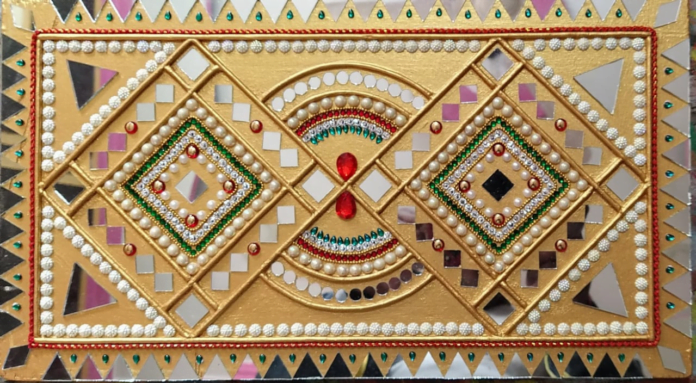
Lippan art, also known as mud relief work, is an ancient and captivating art form that originated in the rural regions of Gujarat, India. It is characterized by its intricate patterns and designs created using a mixture of clay, camel dung, and water. This article provides a comprehensive exploration of lippan art, delving into its history, technique, symbolism, and contemporary relevance.
Historical Origins and Significance:
Lippan art finds its roots in the rural communities of Kutch, Gujarat, where it has been practiced for generations. Mud and Mirror work is mainly done by the women of the Rabari community. The women are so experienced in this art form that they usually don’t draw or trace a pattern before beginning work. Also, Rabari is the pastoral community of Kutch, living in the outskirts of ita villages.Traditionally, lippan art was used to adorn the interiors of Bhungas, circular mud houses with thatched roofs. The work is also a showcase of women’s art who skillfully molded the clay and embellished the walls with intricate designs.
This art form has a unknown past as no records are available to trace its origin. Various communities in Kutch do mud washing in their own distinct style. Artisans of the Muslim community practicing this art form stick to graphic and eye-catchy geometric patterns.
The art form holds cultural and symbolic significance. Lippan art not only beautifies the living spaces but also acts as a protective charm, warding off evil spirits and bringing good fortune to the inhabitants. It also serves as a medium for storytelling, with motifs and designs often representing elements from nature, mythology, and the cultural heritage of the community.
Technique and Process:
The creation of lippan art involves a meticulous process that requires precision and patience. Here is a step-by-step breakdown of the technique:
1. Clay Preparation: A mixture of clay, camel dung, and water is prepared to achieve the desired consistency. The camel dung acts as a binding agent, enhancing the clay’s pliability and strength.
2. Applying the Base: The prepared clay mixture is applied to the wall surface in thin layers, forming a base. The clay is smoothed and leveled to provide a uniform surface for the artistic work.
3. Designing and Relief Work: Using their fingers or simple tools, artists shape the clay to create intricate patterns, geometric designs, or depictions of flora, fauna, and mythological figures. The relief work involves giving depth and dimension to the designs by carefully sculpting the clay.
4. Mirror Embellishment: One of the distinguishing features of lippan art is the incorporation of small mirrors into the wet clay. The mirrors are strategically placed within the designs, reflecting light and adding a shimmering effect to the artwork. They also symbolize prosperity and are believed to ward off negative energies.
5. Finishing Touches: Once the design is complete, the surface is smoothened, ensuring a seamless transition between the relief work and the base. The artwork is left to dry and harden, preserving its longevity.
Contemporary Adaptations and Innovations:
While lippan art has its roots in tradition, contemporary artists have begun to infuse innovative elements into this ancient craft. These adaptations help to keep the art form relevant and appeal to a wider audience. Some of the contemporary adaptations include:
1. Use of Vibrant Colors: Traditional lippan art predominantly features earthy tones. However, modern artists have started experimenting with vibrant colors, adding a contemporary and visually striking element to the artwork.
2. Incorporation of Mixed Media: Artists have begun incorporating additional materials such as beads, sequins, and decorative stones to enhance the aesthetic appeal and texture of the artwork.
3. Integration into Urban Spaces: Lippan art has transcended its traditional boundaries and can now be found adorning urban spaces such as cafes, galleries, and public murals. This integration helps to showcase the cultural heritage of Gujarat and bring lippan art to a broader audience.
One of the distinguishing features of lippan art is the use of mirrors. Small pieces of mirror are embedded into the wet clay, reflecting light and adding a shimmering effect to the artwork. The mirrors not only enhance the visual appeal but also hold cultural significance, symbolizing prosperity and warding off evil spirits.
Preservation and Revival of Cultural Heritage:
Lippan art plays a crucial role in preserving the cultural heritage of Gujarat. It serves as a visual narrative, depicting the rich history, folklore, and traditions of the region. This art not only serves as a decorative element but also plays a crucial role in preserving cultural heritage. It acts as a visual narrative, depicting the rich history, folklore, and traditions of Gujarat. Through lippan art, stories are told, and a sense of identity and pride is instilled in the community.
Lippan art is a testament to the artistic prowess and cultural heritage of Gujarat, India. Its intricate patterns, captivating designs, and fusion of tradition with innovation make it a visually stunning and culturally significant art form. As lippan art continues to evolve and gain recognition, it serves as a reminder of the importance of preserving traditional crafts and celebrating the beauty of diverse artistic expressions.

